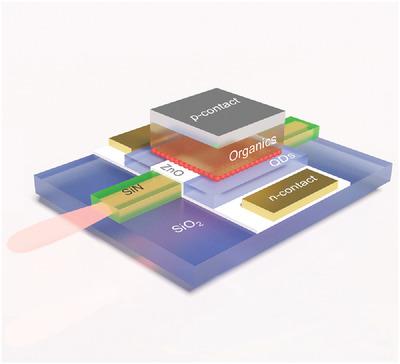当前位置:
X-MOL 学术
›
Laser Photonics Rev.
›
论文详情
Our official English website, www.x-mol.net, welcomes your feedback! (Note: you will need to create a separate account there.)
Waveguide-Coupled Colloidal Quantum Dot Light Emitting Diodes and Detectors on a Silicon Nitride Platform
Laser & Photonics Reviews ( IF 11.0 ) Pub Date : 2021-05-26 , DOI: 10.1002/lpor.202000230 Lukas Elsinger 1 , Robin Petit 2 , Frederik Van Acker 3 , Natalia K. Zawacka 4 , Ivo Tanghe 1 , Kristiaan Neyts 3 , Christophe Detavernier 5 , Pieter Geiregat 4 , Zeger Hens 4 , Dries Van Thourhout 1
Laser & Photonics Reviews ( IF 11.0 ) Pub Date : 2021-05-26 , DOI: 10.1002/lpor.202000230 Lukas Elsinger 1 , Robin Petit 2 , Frederik Van Acker 3 , Natalia K. Zawacka 4 , Ivo Tanghe 1 , Kristiaan Neyts 3 , Christophe Detavernier 5 , Pieter Geiregat 4 , Zeger Hens 4 , Dries Van Thourhout 1
Affiliation

|
Colloidal quantum dots (QDs) are an attractive light source for visible photonics, in particular their widely tunable emission wavelength, inexpensive wet-chemical synthesis and straight-forward hybrid integration can make the difference. In this work, integrated light-emitting diodes are demonstrated based on CdSe/CdS QDs, with the emission directly coupled to a silicon nitride waveguide. The devices feature a record current density of up to 100 A cm−2 and a maximum on-chip power density of almost 1.5 W cm−2 in a single-mode waveguide. Operated as detectors, the photodiodes have a low dark current of 1.5 µA cm−2. It is anticipated, that the devices will find an application in chip-based absorption spectroscopy and bio-sensing, as they can be post-processed on foundry-fabricated waveguide platforms, at a low cost. In addition, this approach provides the missing low-loss waveguide layer, necessary for building an electrically pumped laser using colloidal QDs.
中文翻译:

氮化硅平台上的波导耦合胶体量子点发光二极管和探测器
胶体量子点 (QD) 是可见光子学的一种有吸引力的光源,特别是它们广泛可调的发射波长、廉价的湿化学合成和直接的混合集成可以发挥作用。在这项工作中,基于 CdSe/CdS QD 展示了集成发光二极管,其发射直接耦合到氮化硅波导。这些器件在单模波导中具有高达 100 A cm -2的创纪录电流密度和近 1.5 W cm -2的最大片上功率密度。作为检测器,光电二极管具有 1.5 µA cm -2的低暗电流. 预计这些设备将在基于芯片的吸收光谱和生物传感中得到应用,因为它们可以在代工制造的波导平台上以低成本进行后处理。此外,这种方法提供了缺失的低损耗波导层,这是使用胶体 QD 构建电泵浦激光器所必需的。
更新日期:2021-07-08
中文翻译:

氮化硅平台上的波导耦合胶体量子点发光二极管和探测器
胶体量子点 (QD) 是可见光子学的一种有吸引力的光源,特别是它们广泛可调的发射波长、廉价的湿化学合成和直接的混合集成可以发挥作用。在这项工作中,基于 CdSe/CdS QD 展示了集成发光二极管,其发射直接耦合到氮化硅波导。这些器件在单模波导中具有高达 100 A cm -2的创纪录电流密度和近 1.5 W cm -2的最大片上功率密度。作为检测器,光电二极管具有 1.5 µA cm -2的低暗电流. 预计这些设备将在基于芯片的吸收光谱和生物传感中得到应用,因为它们可以在代工制造的波导平台上以低成本进行后处理。此外,这种方法提供了缺失的低损耗波导层,这是使用胶体 QD 构建电泵浦激光器所必需的。



























 京公网安备 11010802027423号
京公网安备 11010802027423号